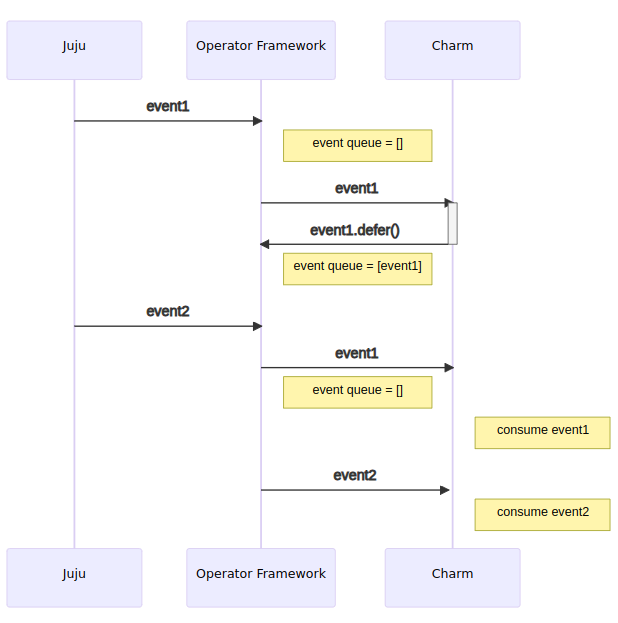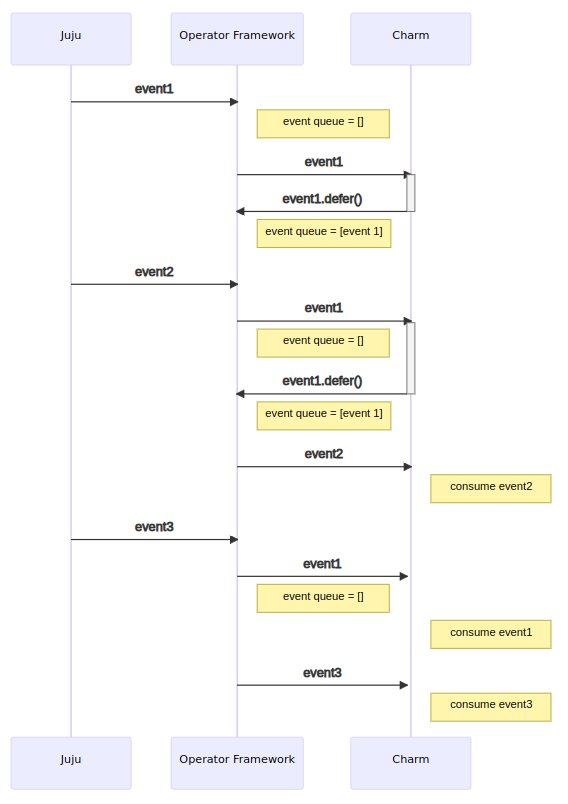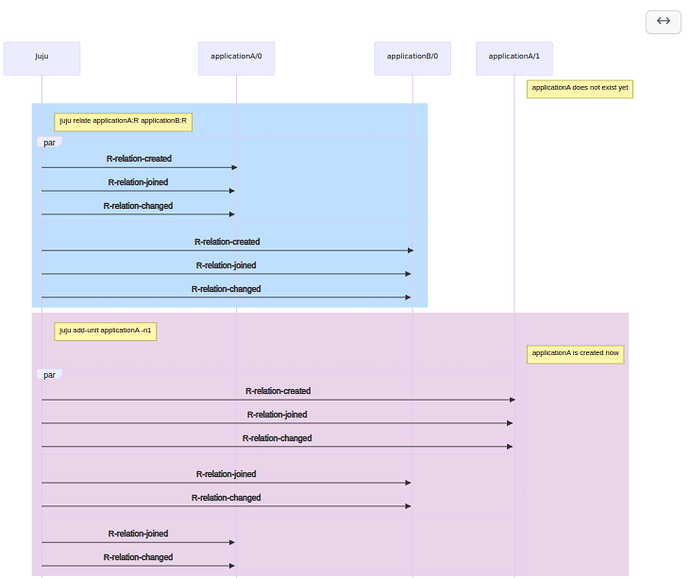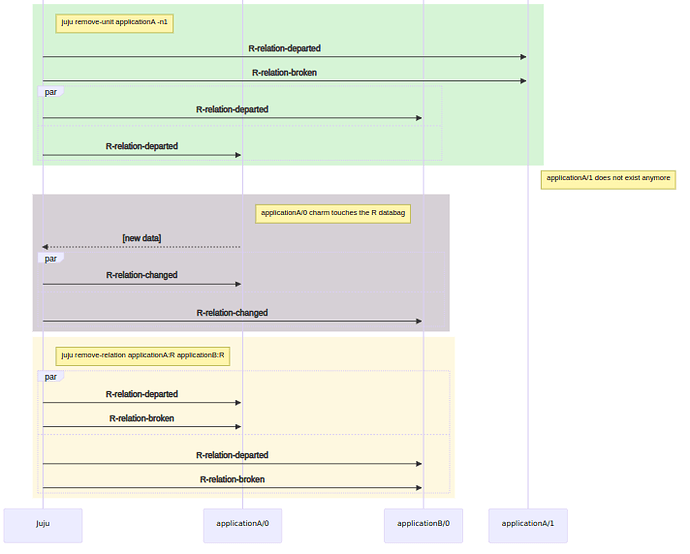See also: Exploring event emission sequences with jhack tail
This document is about the lifecycle of a charm, specifically the Juju events that are used to keep track of it. These events are relayed to charm code by the Operator Framework in specific sequences depending on what’s going on in the Juju model.
It is common wisdom that event ordering should not be generally relied upon when coding a charm, to ensure resilience. It can be however useful to understand the logic behind the timing of events, so as to avoid common mistakes and have a better picture of what is happening in your charm. In this document we’ll learn how:
- A charm’s lifecycle can be seen to consist of three phases, each one with characteristic events and sequences thereof. The fuzziest of the three being the Operation phase, where pretty much anything can happen short of setup events.
- Not all events can be reliably be assumed to occur in specific temporal orders, but some can.
In this document we will not learn:
- What each event means or is typically used to represent about a workload status. For that see the SDK docs.
- What event cascades are triggered by a human administrator running commands through the Juju CLI. For that see this other doc.
The graphs are screenshots of mermaid sources currently available here, pending mermaid support to be available on discourse.
Contents:
- The graph
- Other events
- Notes on the setup phase
- Notes on the operation phase
- Notes on the teardown phase
- Caveats
- Deprecation notices
- Event semantics and data
- Appendices
The graph
Legend
(start)and(end)are ‘meta’ nodes and represent the beginning and end of the lifecycle of a Charm/juju unit. All other nodes represent hooks (events) that can occur during said lifecycle.- Hard arrows represent strict temporal ordering which is enforced by the Juju state machine and respected by the Operator Framework, which mediates between the Juju controller and the Charm code.
- Dotted arrows represent a 1:1 relationship between relation events, explained in more detail down in the Operation section.
- The large yellow boxes represent broad phases in the lifecycle. You can read the graph as follows: when you fire up a unit, there is first a setup phase, when that is done the unit enters a operation phase, and when the unit goes there will be a sequence of teardown events. Generally speaking, this guarantees some sort of ordering of the events: events that are unique to the teardown phase can be guaranteed not to be fired during the setup phase. So a
stopwill never be fired before astart. - The colours of the event nodes represent a logical but practically meaningless grouping of the events.
- green for leadership events
- red for storage events
- purple for relation events
- blue for generic lifecycle events
Workload and substrate-specific events
Note the [workload events] (k8s only) node in the operation phase. That represents all events meant to communicate information about the workload container on kubernetes charms. At the time of writing the only such events are:
All of these can fire at any time whatsoever during the lifecycle of a charm.
Similarly, the [pre/post]-series-upgrade (lxd only) events can only occur on machine charms at any time during the operation phase.
Notes on the setup phase
- The only events that are guaranteed to always occur during Setup are
start,config-changedandinstall. The other events only happen if the charm happens to have (peer) relations at install time (e.g. if a charm that already is related to another gets scaled up) or it has storage. Same goes for leadership events. For that reason they are styled with dashed borders. config-changedoccurs betweeninstallandstartregardless of whether any leadership (or relation) event fires.- Any
*-relation-createdevent can occur at Setup time, but if X is a peer relation, thenX-relation-createdcan only occur at Setup, while for non-peer relations, they can occur also during Operation. The reason for this is that a peer relation cannot be created or destroyed ‘manually’ at arbitrary times, they either exist or not, and if they do exist, then we know it from the start.
Notes on the operation phase
update-statusis fired automatically and periodically, at a configurable regular interval (default is 5m) which can be configured byjuju model-config update-status-hook-interval.collect-metricsis fired automatically and periodically in older juju versions, at a regular interval of 5m, AND whenever the user runsjuju collect-metrics.leader-electedandleader-settings-changedonly fire on the leader unit and the non-leader unit(s) respectively, just like at startup.- There is a square of symmetries between the
*-relation-[joined/departed/created/broken]events:- Temporal ordering: a
X-relation-joinedcannot follow aX-relation-departedfor the same relation ID. Same goes for*-relation-createdand*-relation-broken, as well as*-relation-createdand*-relation-changed. - Ownership:
joined/departedare unit-level events: they fire when an application has a (peer) relation and a new unit joins or leaves. All units (including the newly created or leaving unit), will receive the event.created/brokenare relation-level events, in that they fire when two applications become related or a relation is removed (e.g. viajuju remove-relationor because an application is destroyed). - Number: there is a 1:1 relationship between
joined/departedandcreated/broken: when a unit joins a relation with X other units, X*-relation-joinedevents will be fired. When a unit leaves, all units will receive a*-relation-departedevent (so X of them are fired). Same goes forcreated/brokenwhen two applications are related or a relationship is broken. Find in appendix 1 a somewhat more elaborate example.
- Temporal ordering: a
- Technically speaking all events in this box are optional, but I did not style them with dashed borders to avoid clutter. If the charm shuts down immediately after start, it could happen that no operation event is fired.
- A
X-relation-joinedevent is always followed up (immediately after) by aX-relation-changedevent. But any number of*-relation-changedevents can be fired at any time during operation, and they need not be preceded by a*-relation-joinedevent. - There are more temporal orderings than the one displayed here; event chains can be initiated by human operation as detailed in the SDK docs and the leadership docs. For example, it is guaranteed that a
leader-electedis always followed by a [settings-changed], and that if you remove the leader unit, you should get*-relation-departedand aleader-settings-changedon the remaining units (although no specific ordering can be guaranteed cfr this bug…). - Secret events (in purple) can technically occur at any time, provided your charm either has created a secret, or observes a secret that some other charm has created. Only the owner of a secret can receive
secret-rotateandsecret-expirefor that secret, and only an observer of a secret can receivesecret-changedandsecret-removed.
Notes on the teardown phase
- Both relation and storage events are guaranteed to fire before
stop/removeif they will fire at all. They are optional, in that a departing unit (or application) might have no storage or relations. *-relation-brokenevents in the Teardown phase are fired in case an application is being torn down. These events can also occur at Operation time, if the relation is removed by e.g. a charm or a controller.- The entire teardown phase is skipped if the cloud is killed. The next event the charm will see in this case would be a
startevent. This would happen, for example, onmicrok8s stop; microk8s start.
Caveats
- Events can be deferred by charm code by calling
Event.defer(). That means that the event is put in a queue of deferred events which will get flushed by the operator framework as soon as the next event comes in, and before firing that new event in turn. See Appendix 2 for a visual representation. What this means in practice is that deferring an event can break the temporal ordering of the events as outlined in this graph;defer()ring an event twice will break the ordering guarantees we outlined here. Cf. the appendix for an UML-y representation. Cfr this document on defer for more. - The events in the Operation phase can interleave in arbitrary ways. For this reason it’s essential that hook handlers make no assumptions about each other – each handler should check its preconditions independently and operate under the assumption that the relative ordering is totally arbitrary – except relation events, which have some partial ordering as explained above.
Deprecation notices
leader-deposedis a juju hook that was planned but never actually implemented. You may see a WARNING mentioning it in thejuju debug-logbut you can ignore it.collect-metricsis no longer being fired in recent juju versions.
Event semantics and data
This document is only about the timing of the events; for the ‘meaning’ of the events, other sources are more appropriate; e.g. juju-events. For the data attached to an event, one should refer to the docstrings in the ops.charm.HookEvent subclass that the event you’re expecting in your handler inherits from.
Appendices
Appendix 1: scenario example
This is a representation of the relation events a deployment will receive in a simple scenario that goes as follows:
- We start with two unrelated applications,
applicationAandapplicationB, with one unit each. applicationAandapplicationBbecome related via a relation calledR.applicationAis scaled up to 2 units.applicationAis scaled down to 1 unit.applicationAtouches theRdatabag (e.g. during anupdate-statushook, or as a result of aconfig-changed, an action, a custom event…).- The relation
Ris removed.
Note that many event sequences are marked as ‘par’ for parallel, which means that the events can be dispatched to the units arbitrarily interleaved.
Appendix 2: deferring an event
jhack tail offers functionality to visualize the deferral status of events in real time.
This is the ‘normal’ way of using defer(): an event event1 comes in but we are not ready to process it; we defer() it; when event2 comes in, the operator framework will first flush the queue and fire event1, then fire event2. The ordering is preserved: event1 is consumed before event2 by the charm.

Suppose now that the charm defers event1 again; then event2 will be processed by the charm before event1 is. event1 will only be fired again once another event, event3, comes in in turn.
The result is that the events are consumed in the order: 2-1-3. Beware.

Contributors: @ppasotti



 when I started we thought of this as “the juju state machine”, but it’s not quite that.
when I started we thought of this as “the juju state machine”, but it’s not quite that.